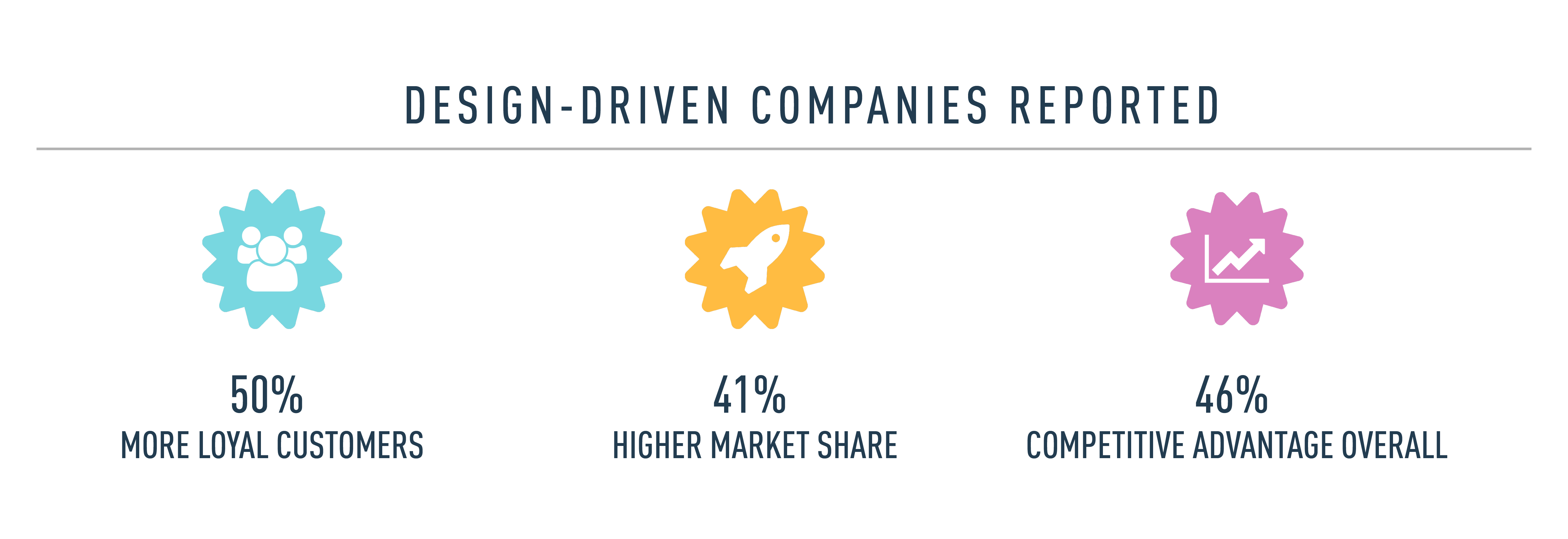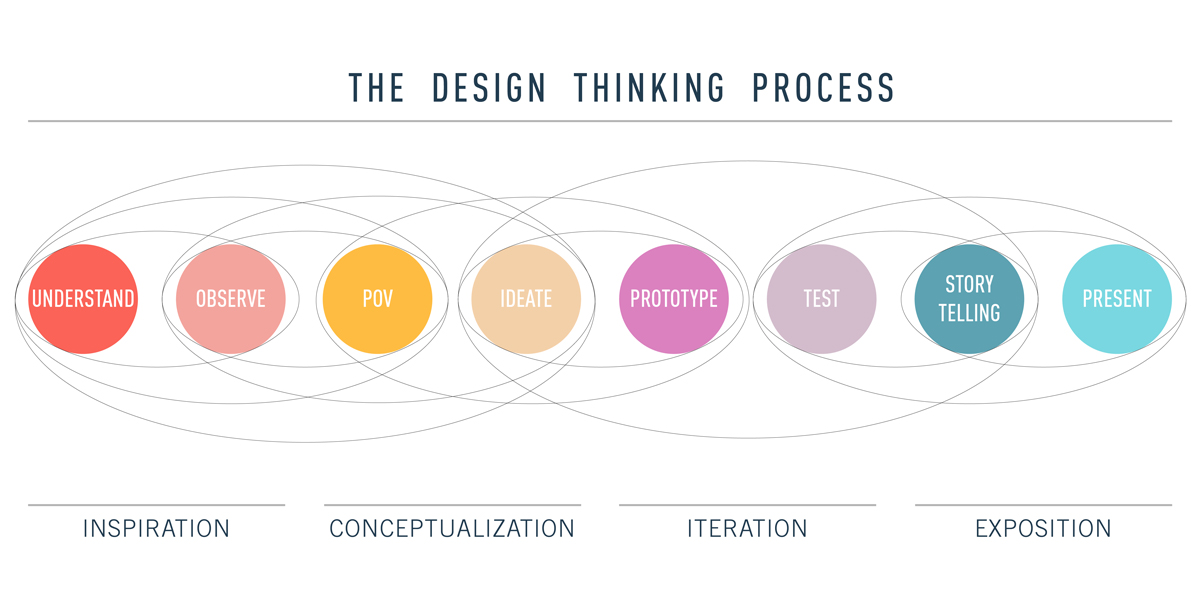Top things to know
- The goal of user experience (UX) design is to create easy, efficient, and pleasant experiences with a brand or business
- UX covers the entire user journey, while user interface (UI) design refers only to the visual and interactive elements of a product’s interface
- A process called Design Thinking is used to conduct research, create solutions, iterate, and test
- Companies often hire for very specific roles within the process, such as UX researcher or interaction designer
- There’s no one path to becoming a UX designer, but many take UX courses to build their portfolios and networks
UX design molds the products and services we use daily: the layout of a supermarket, the ergonomics of a vehicle, and the usability of a mobile app. UX can make or break a business!
In this guide, we’ll take you through the most important aspects of UX design. We’ll cover the basics, the value UX design brings, and outline how you can become a UX designer yourself.
Table of contents
- What is UX design? A definition
- The difference between UX and UI design
- The value of UX design
- Fundamental UX design principles and processes
- What does a UX designer do?
- UX design tools
- UX design skills
- How to become a UX designer
- Next steps
- What is UX design? FAQs
If you’re already ready to get your hands dirty, you can try out our free 5-day short course.
OK, let’s get started.
What is UX design? A definition
User experience (UX) design is the process of creating products, systems, or services that are straightforward, user-friendly, and meaningful.
It’s all about designing easy-to-use solutions that meet a specific need or solve a particular problem.
If you want to manage your finances online, for example, you’ll need a well-designed mobile app. If you’re struggling to concentrate at work due to background noise, you might need a pair of comfortable noise-canceling headphones.
UX design is the process of identifying and understanding the end-users’ needs, and then designing an effective solution.
It considers all the elements that shape a user’s experience with a product or service, and how the overall experience or interaction makes the user feel. Above all else, UX design focuses on usability: in other words, how easy is it for the user to interact with the product or service and accomplish their desired tasks?
UX can mean anything from how a physical product feels in your hand to how straightforward the checkout process is when buying something online.
The goal of UX design is always to create easy, efficient, relevant, and all-round pleasant experiences for the user.
“User experience encompasses all aspects of the end-user’s interaction with the company, its services, and its products.”
— Don Norman, Cognitive Scientist & User Experience Architect
UX designers combine market research, product development, strategy, and design to create seamless user experiences for products, services, and processes.
They build a bridge to the customer, helping the company to better understand—and fulfill—their needs and expectations. We’ll take a closer look at what a UX designer does later on in this guide.
In this video overview, designer Dee explains what UX design is all about:
The difference between UX and UI design
When discussing UX, user interface (UI) design will inevitably crop up. However, it’s important to recognize that, despite often being used interchangeably, UX and UI are two different things.
UI refers to the actual interface of a product, the visual design of the screens a user navigates through when using a mobile app, or the buttons they click when browsing a website.
UI design covers all the visual and interactive elements of a product interface: from typography and color palettes to animations and navigational touch points (such as buttons and scrollbars).
“UX is focused on the user’s journey to solve a problem; UI is focused on how a product’s surfaces look and function.”
— Ken Norton, Partner at Google Ventures, Ex-Product Manager at Google
UX and UI go hand-in-hand, and the design of the product interface has a huge impact on the overall user experience.
Learn more about the difference between UX and UI design in this guide.
The value of UX design
Good UX design enables us to go about our daily lives as effortlessly as possible. From setting an alarm to chatting with friends online, listening to music, or using a calendar app; we’re able to complete these actions easily because of good user experience design.
And the value of UX design isn’t only felt by end-users and customers. It has a major impact on the success (or failure) of a product or service. As such, UX drives immense value for businesses, too.
UX design is crucial for accessibility and inclusivity
The true value of UX design lies in creating products and services that are inclusive, accessible, and enjoyable for everybody.
This is achieved through universal design. In UX, universal design is about creating products, services, environments, and interfaces that are accessible for a diverse range of people, regardless of their abilities, disabilities, age, gender, cultural background, or other characteristics.
The goal of universal design is to ensure that everyone, regardless of their individual differences, can effectively interact with and benefit from the designed experience.
Universal design follows seven key principles:
- Equitable use: The design is useful and marketable to people with diverse abilities.
- Flexibility in use: The design accommodates a wide range of individual preferences and abilities.
- Simple and intuitive use: The use of the design is easy to understand, regardless of the user’s experience, knowledge, language skills, or current concentration level.
- Perceptible information: The design communicates necessary information effectively to the user, regardless of ambient conditions or the user’s sensory abilities.
- Tolerance for error: The design minimizes hazards and the adverse consequences of accidental or unintended actions.
- Low physical effort: The design can be used efficiently and comfortably and with a minimum of fatigue.
- Size and space for approach and use: Appropriate size and space is provided for approach, reach, manipulation, and use regardless of the user’s body size, posture, or mobility.
Learn more:
- 7 Universal design principles to follow to make your UX inclusive
- Why simplicity is essential in UX design
Good design is good business
From a business perspective, designing first-class user experiences is key to ensuring customer satisfaction and building brand loyalty. Only if a product or service is hassle-free and enjoyable will the user want to return.
“Good design is good business.”
— Thomas Watson Jr., CEO, IBM

Design-driven companies have a major competitive advantage
According to a study conducted by the Design Management Institute, design-driven companies consistently outperformed the S&P 500 by 219% over a 10-year period.
Furthermore, a study commissioned by Adobe found that design thinking in business creates a measurable competitive advantage. Design-led companies reported 41% higher market share, 50% more loyal customers, and 46% competitive advantage overall.
User-friendly, universal design is beneficial to everyone, and UX designers are in a position to truly shape the world around us.
Fundamental UX design principles and processes
UX design is founded on certain principles, processes, and methodologies. These guide UX designers in the creation of products and services that are intuitive, meaningful, and effective.
The fundamental principles of UX design
The most important UX design principles are:
- User-Centered Design (UCD): Prioritizing the needs, preferences, and behaviors of users throughout the design process.
- Empathy: Understanding and addressing user pain points, goals, and emotions to create more meaningful experiences.
- Usability: Ensuring designs are easy to use, efficient, and provide a seamless experience.
- Accessibility: Ensuring designs are usable by people with diverse abilities and needs.
- Consistency: Maintaining uniformity in design elements, interactions, and patterns to enhance usability and reduce cognitive load.
- Feedback: Providing users with clear and timely responses to their actions to reinforce system transparency.
- Simplicity: Eliminating unnecessary elements to create intuitive and efficient designs.
- Iterative design: Continuously testing, refining, and improving designs based on user feedback and data.
- Visual hierarchy: Using size, color, contrast, and spacing to guide users’ attention and communicate information effectively.
Learn more: 10 Essential UX Principles to Follow.
Key UX design processes and methodologies
UX design is a highly practical, hands-on discipline. It relies on a variety of processes and techniques, including:
- User research: Gathering insights about user needs, behaviors, and pain points through methods like interviews, surveys, and observation to inform design decisions.
- Information Architecture (IA): Organizing and structuring content in a way that is logical and easy to navigate, ensuring users can find what they need efficiently.
- Wireframing and prototyping: Creating low-fidelity wireframes and interactive prototypes to visualize and test design concepts before final implementation.
- Usability testing: Observing real users interacting with a design to identify usability issues and gather feedback for improvements.
- Design Thinking: A problem-solving framework that emphasizes empathy, ideation, prototyping, and iteration to create user-centered solutions. We’ll take a closer look at the Design Thinking process in the next section.
- Interaction Design (IxD): Defining how users interact with the product, including animations, transitions, and interactive elements, to enhance usability and engagement.
Next, let’s delve deeper into what UX design looks like in action—and what UX designers do on a day-to-day basis.
What does a UX designer do?
“How do I explain what I do at a party? The short version is that I say I humanize technology.”
— Fred Beecher, Director of UX, The Nerdery
UX designers seek to make everyday products, services, and technology as user-friendly and accessible as possible. They employ design thinking to reconcile the user’s desires with technical feasibility and business viability.
The Design Thinking Process
The following diagram shows the Design Thinking Process, adapted from the d.school. The Design Thinking Process can be broken down into four different stages: inspiration, conceptualization, iteration, and exposition.

During the inspiration stage, the UX designer seeks to understand and observe. To do this, they conduct extensive research and competitor analysis to fully grasp the problem or challenge they are setting out to solve. This involves interviewing those who are, or will be, directly engaged with the product.
The user experience designer then uses this feedback to identify the user’s goals, emotions, pain points, and behaviors. All of this information helps to form user personas, composite descriptions of individual users.
The next step is to consider what these personas are trying to accomplish when using a particular product and the journey they will take. The designer considers information architecture and uses various techniques, such as card sorting, to map out user flows.
Read our full guide on the UX design process.
What are a UX designer’s tasks?
Once the user flows have been determined, the designer knows what steps the user needs to take to complete their desired tasks. They will visually brainstorm solutions for each of these steps, creating wireframes and prototypes of what the final product might look like.
With prototypes to hand, the UX designer will then conduct usability tests to see how users interact with the product. This shows whether or not the user can complete their desired tasks or if changes need to be made.
UX designers don’t just come up with solutions to user problems; they also need to present their ideas and designs to key stakeholders as part of their day-to-day work.
Company size determines the scope of what a UX designer does
This is just a broad overview of the UX design process. In reality, tasks will vary depending on both the size and the specific needs of the company.
Larger companies might employ a team of designers, each focusing on a specific aspect of the process, such as research or visual design.
In smaller companies and startups, it’s not unusual for the UX designer to wear many hats and take on the whole spectrum of tasks.
Key questions UX designers ask themselves
No matter what product or service they are designing or what stage of the process they are at, UX designers will ask themselves the following questions:
- Is the product usable? Is it logical, self-explanatory, and easy to use?
- Does the product or service solve an existing user problem?
- Is it accessible to different categories of users? You can read more about accessibility in design further on in the Universal Design section.
- Is the product or service desirable? Does it create a positive experience that the user would happily repeat?
Learn more: What Does a UX Designer Actually Do?
The definition of a UX designer’s role will vary depending on which industry or company you talk to. There’s a growing tendency for companies to hire for very specific roles, such as UX researcher or interaction designer, to cover all of the different aspects of user experience.
What kinds of projects do UX designers work on?
As the tech industry grows, the field of UX design is becoming increasingly varied. UX designers can find themselves working on a wide range of projects within various contexts. The following are just some applications for UX design.
Product design
Product design is the process of conceptualizing, creating, and refining physical or digital items to meet specific user needs and deliver a functional, aesthetically pleasing, and marketable solution. It informs a lot of what UX designers work on daily.
There’s a lot of gray between the two, hence why UX designers often end up working as product designers. More specific products and areas that UX designers work on include:
Website, app, and software design
In the age of the internet and smartphones, the usability of a website, mobile app, or piece of software will largely determine its success on the market. Together with UI designers, UX designers are responsible for ensuring a smooth online experience for the user.
From e-commerce websites to dating apps, from CRM software to web-based email clients, each and every online journey you take has been carefully designed by a UX professional.
Voice design
Voice user interfaces are revolutionizing the way we interact with technology. In the U.S., around 50% of adults use voice search on a daily basis.
UX designers have a huge role to play in the rise of voice, as products like Amazon Alexa can only be successful if they are user-friendly and accessible to the masses. Designing for voice requires a slightly different approach to that of websites and apps: learn more in this beginner’s guide to VUI design.
Virtual reality (VR) and augmented reality (AR)
With the global VR market expected to be worth around $165.9 billion by 2030, UX designers will increasingly be required to design immersive experiences. Likewise, since the Pokemon Go craze hit, augmented reality has also been working its way into the mainstream. More and more, UX designers will have to adapt their approach to ensure the latest technologies are accessible and user-friendly.
Service design
UX design doesn’t only apply to tangible objects and digital products; experiences need to be designed, too. This is where service design comes in.
As explained on its Wikipedia page: “Service design is the activity of planning and organizing people, infrastructure, communication and material components of a service to improve its quality and the interaction between the service provider and its customers.
Service design may function to inform changes to an existing service or create a new service entirely.”
Whenever you buy a coffee, stay in a hotel, or use public transport, service design affects your experience. Service design methodology is very similar to that of classic UX design.
UX design tools
UX designers rely on several different tools as they go about their work.
At the research and inspiration stage, they will use survey and polling tools and video chat software to interview users and gather as much information as possible.
There are also specific programs for wireframing, prototyping, and usability testing, with Balsamiq, InVision, and UsabilityHub among the most popular in the industry.
AI tools are also becoming popular as ways to tackle simpler tasks more efficiently. For more info, read our full guide on the impact of AI on UX design.
In addition to design-specific programs, designers use communication and project management tools to keep track of their work at all times.
You can learn more about UX design tools in our beginner’s guide.
UX design skills
UX designers come from all walks of life, and you don’t necessarily need a university degree to break into the field. Many people switch to UX design after gaining experience in another field—like psychology, computer science, marketing, or customer service.
Employers tend to look for a mixture of design skills, business acumen, and soft skills.
Some requirements you will often see in UX designer job descriptions include:
- Proficiency in creating user stories, personas, sitemaps, wireframes, prototypes, and storyboards
- Ability to plan and conduct user testing, surveys, and formal evaluations
- Ability to iterate your work based on user testing data and qualitative feedback
- Understanding of interaction design principles and information architecture
- Ability to translate goals, objectives, and data into digital experiences
- Understanding of business metrics and how your designs contribute to performance
- Strong communication and presentation skills; an ability to articulate and discuss your design decisions with clients and stakeholders (storytelling is key)
- Flexibility and adaptability
What counts as essential or desirable will vary depending on the company and the nature of the role.
You can learn more about key UX design skills in our guide.
How to become a UX designer
UX design is an extremely multifaceted field. Working in UX requires a highly diverse skill set and a passion for user-centric design.
A career in UX can be very varied, challenging, and financially rewarding; according to Glassdoor, the average salary for a User Experience Designer in the United States is $97,780.
To get started in UX design, start with plenty of reading and research to get to know the UX workflow. Then you can familiarize yourself with industry tools and start to build up a solid design portfolio.
There are many UX courses available that allow learners to master the basics, get critical feedback on their work, and network. We offer a top-rated UX course here at CareerFoundry, check it out here.
In this video, UX and product design professional and expert Maureen Herben shares her experience on the best way to become a UX designer.
While there’s no standard background or path that leads to a career in UX, the best UX designers typically share certain qualities and attributes. These include:
- An ability to think both creatively and analytically
- A strong gift for empathy and a user-first mindset
- An interest in technology and how humans interact with it
- Strong problem-solving skills
- Strong communication skills and ability to collaborate
Read our full guide on how to become a UX designer.
Or read Kylie’s story of how she transitioned out of the hospitality industry to become a UX designer.
Next steps
Now that you’ve seen what a UX designer is, the value and impact of the field, and more, you might want to begin your journey into the field.
Jump right in and take our free UX design short course. You can also speak directly with a program advisor to talk about our full UX program.
If you found this article interesting, you might also enjoy these:
- How to become a UX designer in 2025
- What qualifications do you need to be a UX designer?
- A day in the life of a UX designer
What is UX design? FAQs
What is the meaning of UX design?
UX design refers to the process of designing products, systems, or services that provide meaningful and enjoyable experiences for users. It focuses on usability, accessibility, and the overall interaction between the user and the product, ensuring a seamless, efficient, and user-centered experience.
What exactly does a UX designer do?
A UX designer researches user needs, creates wireframes and prototypes, tests designs for usability, and collaborates with teams to develop intuitive, accessible, and user-friendly products. Their role involves improving user satisfaction by ensuring products are easy to use, visually appealing, and aligned with user goals and business objectives.
Does UX design require coding?
UX design doesn’t necessarily require coding, but understanding basic programming concepts can be helpful for collaborating with developers and ensuring design feasibility. UX designers primarily focus on research, prototyping, and user testing, leaving coding to specialized front-end or software developers in most cases.

